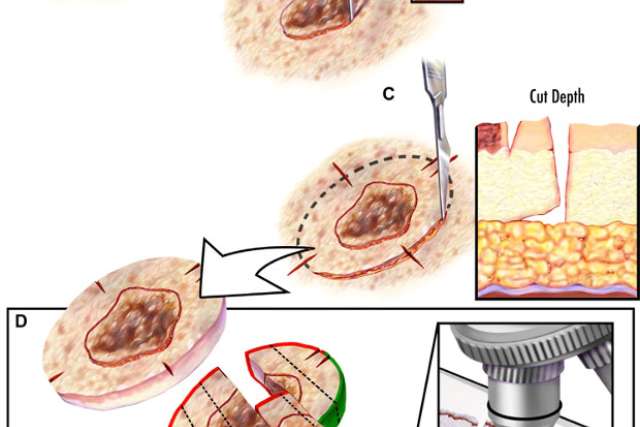A new technique available at UCLA Health to treat early-stage melanomas has demonstrated success in achiev ing cure rates greater than 99%. “It is the single best thing that’s happened in the surgical management of early melanomas in functionally or cosmetically challenging areas,” says dermatologic surgeon Teo Soleymani, MD.


UCL A Health is the first center in Southern California to employ the procedure, which uses standard Mohs micrographic surgery — considered the gold standard for treatment of the most common forms of skin cancer — combined with a technique called intraoperative immunohistochemical staining. Immunohistochemical staining uses specialized antibodies that specifically target melanoma cells, so the surgeon can precisely visualize where the tumor begins and ends. This, Dr. Soleymani says, eliminates the “guess work” and the need to take large amounts of tissues, and it enables the surgeon to fully remove the tumor with nearly 100% accuracy.
Results from several landmark studies of the combined Mohs-immunohistochemical staining procedure have shown a tumor-cure rate of 99.5% to 99.8%, says Dr. Soleymani, who introduced the procedure at UCLA Health.
UCLA is the only center in Southern California offering the treatment, which is available at only a handful of top health care institutions across the country. “It’s nice to add UCLA’s name to this elite group of premier institutions,” Dr. Soleymani says.
Dr. Soleymani calls this treatment a game changer for older adults, who grew up in an era when sun protection wasn’t stressed. It is designed to treat early-stage melanomas in challenging areas, such as the head, neck, hands, feet and genitalia, and those that arise from chronically sun-damaged skin. He notes that melanomas in those areas are particularly difficult to treat because of the difficulty in obtaining clear surgical margins — the noncancerous, healthy tissue surrounding the melanoma — with standard techniques.
Dr. Soley mani gives t he example of a melanoma on the rim of the nose or the eyelid, for which surgeons are often unable to take a standard margin or a large piece of healthy tissue around the tumor, which would result in significant cosmetic and functional disfigurement. More significantly, much of the extent of the melanoma is beyond what a surgeon’s eyes can see, he says.
Results from several landmark studies of the combined Mohs-immunohistochemical staining procedure have shown a tumor-cure rate of 99.5% to 99.8%.
“With this new technique, we’re able to remove the tumor and process it in a way where we can look at 100% of the margin, but also use these newly advanced antibody stains to stain for the tumor right at the time of surgery,” Dr. Soleymani says. “If the tumor has roots going deep or to the side, we can see that with these stains.”
The patient is fully awake during surgery, and reconstruction is often performed on the same day. Dr. Soleymani notes that the procedure is particularly benef icial for patients in sunny states, such as California, where the incidence of melanoma has been increasing. “Levels of breast cancer and lung cancer have plateaued, but every year melanoma increases,” he says. “It’s great to now have this treatment option for our aging population.”
